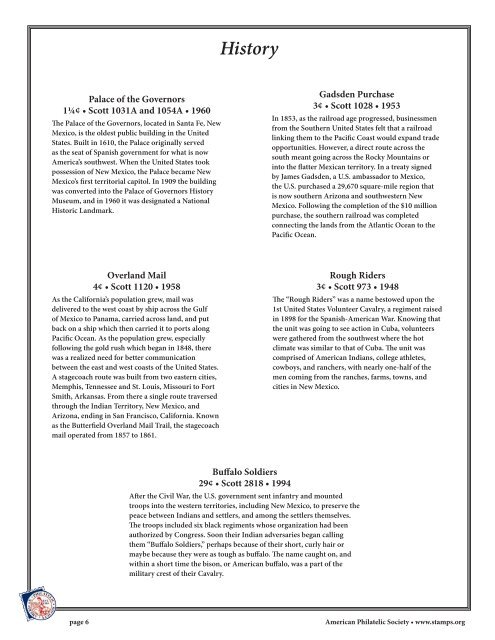New Mexico - American Philatelic Society
New Mexico - American Philatelic Society
New Mexico - American Philatelic Society
Create successful ePaper yourself
Turn your PDF publications into a flip-book with our unique Google optimized e-Paper software.
History<br />
Palace of the Governors<br />
1¼¢ • Scott 1031A and 1054A • 1960<br />
The Palace of the Governors, located in Santa Fe, <strong>New</strong><br />
<strong>Mexico</strong>, is the oldest public building in the United<br />
States. Built in 1610, the Palace originally served<br />
as the seat of Spanish government for what is now<br />
America’s southwest. When the United States took<br />
possession of <strong>New</strong> <strong>Mexico</strong>, the Palace became <strong>New</strong><br />
<strong>Mexico</strong>’s first territorial capitol. In 1909 the building<br />
was converted into the Palace of Governors History<br />
Museum, and in 1960 it was designated a National<br />
Historic Landmark.<br />
Gadsden Purchase<br />
3¢ • Scott 1028 • 1953<br />
In 1853, as the railroad age progressed, businessmen<br />
from the Southern United States felt that a railroad<br />
linking them to the Pacific Coast would expand trade<br />
opportunities. However, a direct route across the<br />
south meant going across the Rocky Mountains or<br />
into the flatter Mexican territory. In a treaty signed<br />
by James Gadsden, a U.S. ambassador to <strong>Mexico</strong>,<br />
the U.S. purchased a 29,670 square-mile region that<br />
is now southern Arizona and southwestern <strong>New</strong><br />
<strong>Mexico</strong>. Following the completion of the $10 million<br />
purchase, the southern railroad was completed<br />
connecting the lands from the Atlantic Ocean to the<br />
Pacific Ocean.<br />
Overland Mail<br />
4¢ • Scott 1120 • 1958<br />
As the California’s population grew, mail was<br />
delivered to the west coast by ship across the Gulf<br />
of <strong>Mexico</strong> to Panama, carried across land, and put<br />
back on a ship which then carried it to ports along<br />
Pacific Ocean. As the population grew, especially<br />
following the gold rush which began in 1848, there<br />
was a realized need for better communication<br />
between the east and west coasts of the United States.<br />
A stagecoach route was built from two eastern cities,<br />
Memphis, Tennessee and St. Louis, Missouri to Fort<br />
Smith, Arkansas. From there a single route traversed<br />
through the Indian Territory, <strong>New</strong> <strong>Mexico</strong>, and<br />
Arizona, ending in San Francisco, California. Known<br />
as the Butterfield Overland Mail Trail, the stagecoach<br />
mail operated from 1857 to 1861.<br />
Rough Riders<br />
3¢ • Scott 973 • 1948<br />
The “Rough Riders” was a name bestowed upon the<br />
1st United States Volunteer Cavalry, a regiment raised<br />
in 1898 for the Spanish-<strong>American</strong> War. Knowing that<br />
the unit was going to see action in Cuba, volunteers<br />
were gathered from the southwest where the hot<br />
climate was similar to that of Cuba. The unit was<br />
comprised of <strong>American</strong> Indians, college athletes,<br />
cowboys, and ranchers, with nearly one-half of the<br />
men coming from the ranches, farms, towns, and<br />
cities in <strong>New</strong> <strong>Mexico</strong>.<br />
Buffalo Soldiers<br />
29¢ • Scott 2818 • 1994<br />
After the Civil War, the U.S. government sent infantry and mounted<br />
troops into the western territories, including <strong>New</strong> <strong>Mexico</strong>, to preserve the<br />
peace between Indians and settlers, and among the settlers themselves.<br />
The troops included six black regiments whose organization had been<br />
authorized by Congress. Soon their Indian adversaries began calling<br />
them “Buffalo Soldiers,” perhaps because of their short, curly hair or<br />
maybe because they were as tough as buffalo. The name caught on, and<br />
within a short time the bison, or <strong>American</strong> buffalo, was a part of the<br />
military crest of their Cavalry.<br />
page 6<br />
<strong>American</strong> <strong>Philatelic</strong> <strong>Society</strong> • www.stamps.org

















